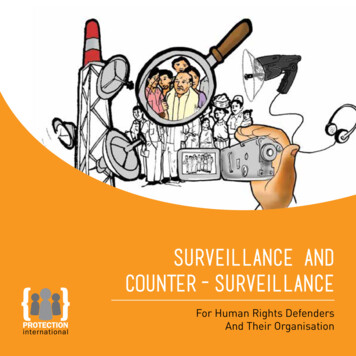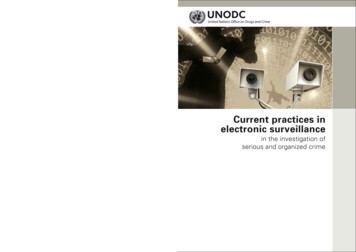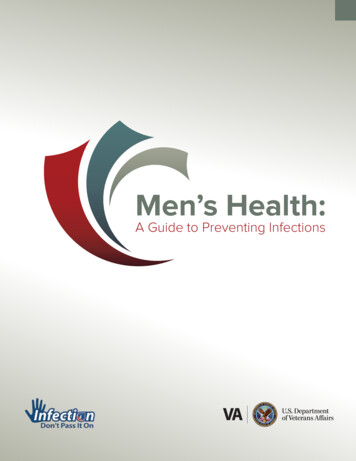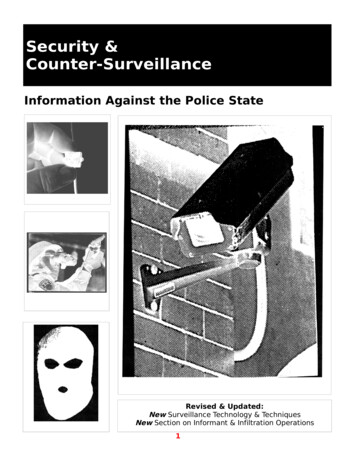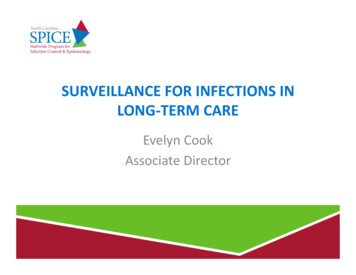
Transcription
SURVEILLANCE FOR INFECTIONS INLONG‐TERM CAREEvelyn CookAssociate Director
IF YOU WANTED TO COMPARE YOUR INFECTIONSURVEILLANCE DATA TO ANOTHER NURSING HOME IN YOURCOMMUNITY THAT CARED FOR A SIMILAR RESIDENTPOPULATION, HOW CONFIDENT ARE YOU THAT EVENTS WILLBE TRACKED IN THE SAME WAYA. Completely ConfidentB. Slightly ConfidentC. Highly ConfidentD. I’m not even sure I can compare my own surveillancedata from year to yearTracking Infections in Long‐term Care Facilities Using NHSN; Training March 20, 2017
Objectives Discuss the importance of surveillance Describe standardized surveillance definitions Discuss ways to implement and applysurveillance definitions
“Surveillance is a comprehensive method ofmeasuring outcomes and related processesof care, analyzing the data, and providinginformation to members of the healthcareteam to assist in improving those outcomesand processes”2015
ReduceInfectionRatesRequired asaComponentof PlanEducationof HCPEstablishBaselineDataWHY enessofInterventions
How is Surveillance Performed?
Assess the Population What is the geographic location of the long‐term carefacility? What types of residents are served? What are the most common diagnoses? What are the most frequently performed invasiveprocedures? Which services or treatments are utilized most frequently? What types of residents are at greatest risk of infection? Are there any health concerns emerging from thecommunity?
Types of Surveillance Total (or Whole) House Surveillance All HAIs are monitored in the entire population Calculate rates for specific population (not anoverall facility wide rate) Targeted Surveillance Particular care units Infections related to medical devices Organisms of epidemiological importance Combination Surveillance Strategy Most use a combination and monitor targeted eventsthat occur in defined populations while concurrentlymonitoring select HAIs and laboratory reports fromhouse‐wide locationsExamples might be MRSA and C difficile house wide but UTIs inresidents with indwelling catheters only.
Selection of Processes and OutcomesProcesses Hand hygiene Urinary Catheter insertion/maintenanceOutcomes Acute respiratory infections Urinary tract infections Skin/Soft Tissue Infections Gastroenteritis
Consideration for choosing Outcomes Mandatory/requiredFrequency (incidence) of the infectionCommunicabilitySystem/resident cost ( mortality,hospitalization) Early DetectionOutcomes selected for surveillance should be re‐evaluatedannually as a component of the IP risk assessment
Types of infection preventionsurveillance include which of thefollowing?A.B.C.D.E.TargetedTotal houseCombination surveillanceA and BA, B and CCorrect Response is E
Infections that should be included inroutine surveillancePoints to ConsiderEvidence of transmissibilityin a healthcare settingInfectionsCommentsViral respiratory tractAssociated with outbreaksinfections, viral GE, and viral among residents and HCP inconjunctivitisLTCFsProcesses available toprevent acquisition ofinfectionClinically significant cause of Pneumonia, UTI, GI tractmorbidity or mortalityinfections, (including C.difficile) and SSTIAssociated withhospitalization andfunctional decline in LTCFresidentsSpecific pathogens causingserious outbreaksA single laboratory‐confirmed case shouldprompt further investigationAny invasive group AStreptococcus infection,acute viral hepatitis,norovirus, scabies, influenza
Infections that could be included inroutine surveillancePoints to ConsiderInfections with limitedtransmissibility in ahealthcare settingsInfections with limitedpreventabilityInfectionsCommentsEar and sinus infections,fungal oral and skininfections and herpetic skininfectionsAssociated with underlyingcomorbid conditions andreactivation of endogenousinfection
Infections for which other accepteddefinitions should be applied in LTCFsurveillancePoints to ConsiderInfectionsInfections with otheraccepted definitions (mayapply to only specific at‐riskresidents)Surgical site infections,central‐line‐ associatedbloodstream infections specific definitionswere not developed. Referto the National HealthcareSafety Network’s criteria
Sources of Data for Surveillance Clinical ward/unit rounds Medical Chart Lab reports Kardex/Patient Profile/Temperaturelogs Antibiotic Starts
IMPLEMENTING AND APPLYINGSURVEILLANCE DEFINITIONSAND PRINCIPALS
National Healthcare SafetyNetwork (NHSN) NHSN is an internet‐based surveillance systemthat integrates the surveillance systemspreviously managed separately in the Divisionof Healthcare Quality Promotion (DHQP) atCDC– National Nosocomial Infections Surveillance (NNIS)system– Dialysis Surveillance Network (DSN)– National Surveillance System for HealthcareWorkers (NaSH)
Purposes of NHSNOriginal Collect data from a sample of US healthcarefacilities to permit valid estimation of the– magnitude of adverse events among patientsand healthcare personnel– adherence to practices known to be associatedwith prevention of healthcare‐associatedinfections (HAI) Analyze and report collected data to permitrecognition of trends
Purposes of NHSN Provide facilities with risk‐adjusted data that canbe used for inter‐facility comparisons and localquality improvement activities Assist facilities in developing surveillance andanalysis methods that permit timely recognitionof patient and healthcare personnel safetyproblems and prompt intervention withappropriate measures Conduct collaborative research studies withmembers
Purposes of NHSN“Ongoing” Facilities that participate in certain reportingprograms operated by the Centers for Medicareand Medicaid Services (CMS) do so through use ofNHSN. Furthermore, some U.S. states use NHSN as ameans for healthcare facilities to submit data onhealthcare‐associated infections (HAIs) mandatedthrough their specific state legislation.
Long‐term Care Facility Component NHSNHealthcare‐associatedInfections (HAI)Urinary TractInfections(URI)Laboratory‐Identified (LabID )EventPreventionProcess MeasuresMulti‐drugResistantOrganisms(MDRO)Hand HygieneClostridiumdifficileInfection (CDI)Gowns ex.html
Guiding Principles for LTCF Criteria Infection surveillance only Applied retrospectively as it relates to clinicaldiagnosis/treatment Focus on transmissible/preventable infections– Not for case finding– Not for diagnostic purposes– Not for clinical decision making
Attribution of infection to LTCF No evidence of an incubating infection at the timeof admission to the facility– Basis of clinical documentation of appropriate signsand symptoms and not solely on screeningmicrobiologic data Onset of clinical manifestation occurs 2 calendardays after admission.
Attribution of infection to LTCF All symptoms must be new or acutely worse Non‐infectious causes of signs and symptomsshould always be considered prior to diagnosis Identification of an infection should not be basedon a single piece of evidence– Clinical, microbiologic, radiologic Diagnosis by physician insufficient (based ondefinition)
Constitutional RequirementsFever: A single oral temperature 37.8 C [100 F], OR Repeated oral temperatures 37.2 C [99 F];rectal temperature 37.5 (99.5 F) OR 1.1 C [2 F] over baseline from a temperaturetaken at any siteNo time frame provided?
Constitutional RequirementsLeukocytosis Neutrophilia 14000 WBC/mm3OR Left shift ( 6% bands or 1500 bands/mm3)
Constitutional RequirementsAcute Change in Mental Status from Baseline Based on Confusion Assessment Method (CAM) criteriaavailable in MDSChangeCriteriaAcute OnsetEvidence of acute change in mental status from resident baselineFluctuatingBehavior fluctuating (e.g., coming and going or changing in severityduring assessment)InattentionResident has difficulty focusing attention (e.g., unable to keep track ofdiscussion or easily distractedDisorganized ThinkingResident’s thinking is incoherent (e.g., rambling conversation, unclearflow of ideas)EitherAltered level ofconsciousnessResident’s level of consciousness is described as different from /orbaseline (e.g., hyperalert, sleepy, drowsy, difficult arouse,nonresponsive)
Constitutional RequirementsAcute Functional Decline New 3 point increase in total ADL score (0‐28) frombaseline based on 7 ADLs {0 independent; 4 totaldependence}1.2.3.4.5.6.7.Bed mobilityTransferLocomotion within LTCFDressingToilet usePersonal hygieneEating
QuestionWhich statement(s) meet constitutionalrequirements?1. The resident must have a temperature 101 F2. The resident doesn’t seem to be herself today3. The resident hasn’t been ambulatory for 3months4. The resident has a WBC count 15000 WBC/mm3
Respiratory Tract InfectionsCriteriaA. Common cold syndrome/pharyngitisAt least two criteria present1. Runny nose or sneezing2. Stuffy nose (i.e., congestion)3. Sore throat or hoarseness or difficultyswallowing4. Dry cough5. Swollen or tender glands in neckCommentsFever may or may not be present. Symptomsmust be new, and not attributable to allergies
Respiratory Tract InfectionsCriteriaB. Influenza‐like IllnessBoth criteria 1 and 2 present1. FeverCommentsIf criteria for influenza‐like illness and anotherupper or lower respiratory tract infection aremet at the same time, only the diagnosis ofinfluenza‐like illness should be used2. At least three of the following symptomsub‐criteria (a‐f) presenta. Chillsb. New headache or eye painc. Myalgias or body achesd. Malaise or loss of appetitee. Sore throatf. New or increased dry coughDue to increasing uncertainty surroundingthe timing of the start of influenza season,the peak of influenza activity and the lengthof the season, ‘seasonality’ is no longer partof the criteria to define influenza‐like illness
Respiratory Tract InfectionsCriteriaCommentsC. PneumoniaAll criteria 1‐3 present1. Interpretation of chest radiograph asdemonstrating pneumonia or the presence ofnew infiltrate2. At least one of the following respiratory sub‐criteria (a‐f) presenta. New or increased coughb. New or increased sputum productionc.O2 saturation 94% on room air or areduction in O2 saturation of more than3% from baselined. New or changed lung exam abnormalitiese. Pleuritic chest painf.Respiratory rate of 25/min3. At least one constitutional criteriaFor both pneumonia and lower respiratorytract infections, presence of underlyingconditions which could mimic a respiratorytract infection presentation (congestive heartfailure, interstitial lung disease), should beexcluded by review of clinical records and anassessment of presenting symptoms andsigns
Respiratory Tract InfectionsCriteriaCommentsD. Lower respiratory tract (Bronchitis or Tracheo‐bronchitisAll criteria 1‐3 present1. Chest radiograph not performed or negativefor pneumonia or new infiltrate.2. At least two of the following respiratory sub‐criteria (a‐f) presenta. New or increased coughb. New or increased sputum productionc.O2 saturation 94% on room air or areduction in O2 saturation of more than3% from baselined. New or changed lung exam abnormalitiese. Pleuritic chest painf.Respiratory rate of 25/min3. At least one constitutional criteriaFor both pneumonia and lower respiratorytract infections, presence of underlyingconditions which could mimic a respiratorytract infection presentation (congestive heartfailure, interstitial lung disease), should beexcluded by review of clinical records and anassessment of presenting symptoms andsigns
McGeer Urinary Tract InfectionsCriteriaA.Commentsc)For Residents without an indwellingcatheterBoth criteria 1 and 2 present1.At least one of the following sign/symptomsub‐criteria (a‐c) present:a)b)Acute dysuria or acute pain,swelling, or tenderness of the testes,epididymis, or prostateFever or leukocytosisIn the absence of fever ofleukocytosis, then at least two ormore of the following localizingurinary symptomsi.Suprapubic painii.Gross hematuriaiii.New or marked increase inincontinenceiv.New or marked increase inurgencyv.New or marked increase infrequencyandAt least one of the following localizingurinary tract sub‐criteria:i.Acute costovertebral anglepain or tendernessii.Suprapubic painiii.Gross hematuriaiv.New or marked increase inincontinencev.New or marked increase inurgencyvi.New or marked increase infrequency2.One of the following microbiologic sub‐criteriaa)b) 105 cfu/ml of no more than 2species of microorganisms in avoided urine 102 cfu/ml of any number oforganisms in a specimen collected byan in and out catheterUTI should be diagnosed when thereare localizing s/s and a positive urinarycultureA diagnosis of UTI can be madewithout localizing symptoms if a bloodculture isolate of the same organismisolated from the urine and there is noalternate sight of infectionIn the absence of a clear alternatesource, fever or rigors with a positiveurine culture in a non‐catheterizedresident will often be treated as a UTI.However evidence suggest most of thethese episodes are not from a urinarysourcePyuria does not differentiatesymptomatic UTI from asymptomaticbacturiaAbsence of pyuria in diagnostic testexcludes symptomatic UTI in residentsof LTCFUrine specimens should be processedwithin 1‐2 hours, or refrigerated andprocessed with in 24 hours.
NHSN Urinary Tract InfectionsFor Residents without an indwelling catheterCriteriaMust meet criteria 1a OR 2a1aCommentsOR 3aTwo or more of the following:Either of the following:1. Costovertebral angle pain or tenderness1. Acute dysuria2. New or marked increase in suprapubictenderness2. Acute pain, swelling or tenderness of thetestes, epididymis or prostate3. Gross hematuria4. New or marked increase in incontinence2a5. New or marked increase in urgencyEither of the following:6. New or marked increase in frequency1. FeverAND2. LeukocytosisEither of the following:ANDOne or more of the following:1. Costovertebral angle pain or tenderness2. New or marked increase in suprapubictenderness3. Gross hematuria4. New or marked increase in incontinence5. New or marked increase in urgency6. New or marked increase in frequency Fever can be used tomeet SUTI criteria evenif the resident hasanother possible causefor the fever Fever definition sameas McGeer Leukocytosis definitionsame as McGeer1. Specimen collected from clean catch voidedurine and positive culture with no more than2 species of microorganisms, at least one ofwhich is bacteria of 10⁵ CFU/ml2.Specimen collected from in/out straightcatheter and positive culture with anymicroorganism, at least one of which isbacteria of 10² CFU/mlNotes:Yeast and other microorganisms whichare not bacteria are not acceptableUTI pathogens
McGeer Urinary Tract InfectionsCriteriaCommentsB. For the resident with an indwelling catheterBoth criteria 1 and 2 present1. At least one of the following sign/symptomsub‐criteria (a‐d) present:Recent catheter trauma, catheter obstruction ornew onset hematuria are useful localizing signsconsistent with UTI, but not necessary for diagnosisa) Fever, rigors, or new onset hypotension,with no alternate site of infectionb) Either acute change in mental status oracute functional decline with no alternatediagnosis and Leukocytosisc) New onset suprapubic pain orcostovertebral angle pain or tendernessd) Purulent discharge from around thecatheter or acute pain, swelling, ortenderness of the testes, epididymis, orprostate2. Urinary catheter culture with 105 cfu/ml ofany organism(s)Urinary catheter specimens for culture should becollected following the replacement of the catheter(if current catheter has been in place for 14 days)
NHSN Urinary Tract InfectionsFor the resident with an indwelling catheterCriteriaCommentsAnd any of the following:If urinary catheter removed within last 2 calendarBoth criteria 1 and 2 presentdays (day of removal is day 1, so day of removal or1. At least one or more of the following:following day)a) Fever (same as McGeer)1. Specimen collected from clean catch voidedurine and positive culture with no more than 2b) Rigorsspecies of microorganisms, at least one ofc) New onset hypotension, with nowhich is bacteria of 10⁵ CFU/mlalternate site of infection2. Specimen collected from in/out straightd) New onset confusion/functional declinecatheter and positive culture with anyAND Leukocytosismicroorganism, at least one of which is bacteriaAND of 10² CFU/mle) New costovertebral angle pain ortendernessIf urinary catheter in place:f) New or marked increase in suprapubic1. Specimen collected from indwelling cathetertendernessand positive culture with any microorganism, atg) Acute pain, swelling, or tenderness of theleast one of which is bacteria of 10⁵ CFU/mltestes, epididymis, or prostateNotes:Yeast and other microorganisms which are not bacteria are noth) Purulent discharge from around theacceptable UTI pathogenscatheterCA‐SUTI
NHSN Notes Indwelling urinary catheter should be in place for a minimumof 2 calendar days before infection onset (day 1 day ofinsertion) Indwelling urinary catheter: a drainage tube that is insertedinto the urinary bladder through the urethra, is left in placeand is connected to a closed collection system, also called afoley catheter. Indwelling urinary catheters do not includestraight in‐and‐out catheters or suprapubic catheters (thesewould be captures as SUTIs, not CA‐SUTIs) Indwelling catheters which have been in place for 14 daysshould be changed prior to specimen collection but failure tochange catheter does not exclude a UTI for surveillancepurposes
What do the Guidelines Say? Specimens collected through the catheter present for morethan a few days reflect biofilm microbiology. For residentswith chronic indwelling catheters and symptomatic infection,changing the catheter immediately prior to institutingantimicrobial therapy allows collection of a bladder specimen,which is a more accurate reflection of infecting organisms. Urinary catheters coated with antimicrobial materials havethe potential to decrease UTIs but have not been studied inthe LTCF setting.SHEA/APIC Guideline: Infection prevention and control in the long‐term care facility Philip W. Smith, MD, GailBennett, RN, MSN, CICb Suzanne Bradley, MD, Paul Drinka, MD, Ebbing Lautenbach, MD, James Marx, RN, MS,CIC, Lona Mody, MD, Lindsay Nicolle, MD and Kurt Stevenson, MD July 2008
Skin, Soft Tissue and Mucosal InfectionsCriteriaA. Cellulitis/soft tissue/wound infectionAt least one of the following criteria is present1. Pus present at a wound, skin, or soft tissue site2. New or increasing presence of at least four ofthe following sign/symptom sub‐criteriaa) Heat at affected siteb) Redness at affected siteCommentsMore than one resident with streptococcal skininfection from the same serogroup (e.g., A, B, C, G)in a LTCF may suggest an outbreakFor wound infections related to surgicalprocedures: LTCF should use the CDC’s NHSNsurgical site infection criteria and report theseinfections back to the institution performing theoriginal surgeryc) Swelling at affected sited) Tenderness or pain at affected sitee) Serous drainage at affected sitef)One constitutional criteriaPresence of organisms cultured from the surface(e.g., superficial swab culture) of a wound is notsufficient evidence that the wound is infected
Skin, Soft Tissue and Mucosal InfectionsCriteriaB. ScabiesBoth criteria 1 and 2 present1. A maculopapular and/or itching rash2. At least one of the following sub‐criteria:a) Physician diagnosisb) Laboratory confirmation (scrapping orbiopsy)c) Epidemiologic linkage to a case of scabieswith laboratory confirmationCommentsCare must be taken to rule out rashes due to skinirritation, allergic reactions, eczema, and other non‐infectious skin conditionsAn epidemiologic linkage to a case can beconsidered if there is evidence of geographicproximity in the facility, temporal relationship tothe onset of symptoms, or evidence of a commonsource of exposure (i.e., shared caregiver).
Skin, Soft Tissue and MucosalInfectionsCriteriaC. Fungal oral/perioral and skin infectionsOral candidiasis:Both criteria 1 and 2 present:1. Presence of raised white patches on inflamedmucosa, or plaques on oral mucosaCommentsMucocutaneous candida infections are usually dueto underlying clinical conditions such as poorlycontrolled diabetes or severe immunosuppression.Although not transmissible infections in thehealthcare setting, they can be a marker forincreased antibiotic exposure2. Medical or dental provider diagnosisFungal skin Infection:Both criteria 1 and 2 present:1. Characteristic rash or lesion2. Either a medical provider diagnosis orlaboratory confirmed fungal pathogen fromscrapping or biopsyDermatophytes have been known to causeoccasional infections, and rare outbreaks, in the LTCsetting.
Skin, Soft Tissue and Mucosal InfectionsCriteriaD. Herpes viral skin infectionsHerpes simplex infectionBoth criteria 1 and 2 present:1. A vesicular rash2. Either physician diagnosis or laboratoryconfirmationHerpes zoster infectionBoth criteria 1 and 2 present:1. A vesicular rash2. Either physician diagnosis or laboratoryconfirmationCommentsReactivation of old herpes simplex (“cold sores”) orherpes zoster (“shingles”) is not considered ahealthcare‐associated infectionPrimary herpes viral skin infections are veryuncommon in LTCF, except in pediatric populationswhere it should be considered healthcare‐associated.
Skin, Soft Tissue and Mucosal InfectionsCriteriaE. ConjunctivitisAt least one of the following criteria present:1. Pus appearing from one or both eyes, presentfor at least 24 hours2. New or increasing conjunctival erythema, withor without itching.3. New or increased conjunctival pain, present forat least 24 hours.CommentsConjunctivitis symptoms (“pink eye”) should not bedue to allergic reaction or trauma.
Gastrointestinal Tract InfectionsCriteriaA. GastroenteritisAt least one of the following criteria present1.Diarrhea, three or more liquid or watery stoolsabove what is normal for the resident within a 24hour period2.Vomiting, two or more episodes in a 24 hourperiod3.Both of the following sign/symptom sub‐criteriapresent:a)A stool specimen positive for a pathogen(such as Salmonella, Shigella, E. coli0157:H7, Campylobacter species, rotavirus)b) At least one of the following GI nal painiv.DiarrheaCommentsCare must be taken to exclude non‐infectiouscauses of symptoms. For instance, new medicationmay cause diarrhea, nausea/vomiting; initiation ofnew enteral feeding may be associated withdiarrhea; nausea or vomiting may be associatedwith gallbladder disease.Presence of new GI symptoms in a single residentmay prompt enhanced surveillance for additionalcases.In the presence of an outbreak, stool fromspecimens should be sent to confirm the presenceof norovirus, or other pathogens (such as rotavirusand E. coli 0157:H7).
Gastrointestinal Tract InfectionsCriteriaB. Norovirus gastroenteritisBoth criteria 1 and 2 present1. At least one of the following GI sub‐criteriaa) Diarrhea, three or more liquid or waterystools above what is normal for theresident within a 24 hour periodb) Vomiting, two or more episodes in a 24hour period2. A stool specimen positive for detection ofnorovirus either by electron microscopy,enzyme immune assay, or by a moleculardiagnostic test such as polymerase chainreaction (PCR).CommentsIn the absence of laboratory confirmation, anoutbreak (2 or more cases occurring in a LTCF) ofacute gastroenteritis due to norovirus infection in aLTCF may be assumed to be present if all of thefollowing criteria are present (“Kaplan criteria”)a) Vomiting in more than half of affected personsb) A mean (or median) incubation period of 24‐48hoursc) A mean (or median) duration of illness of 12‐60hoursd) No bacterial pathogen is identified in stoolculture.
Gastrointestinal Tract InfectionsCriteriaC.Clostridium difficile gastroenteritisBoth criteria 1 and 2 present1.One of the following GI sub‐criteriaa)Diarrhea, three or more liquid or waterystools above what is normal for the residentwithin a 24 hour periodb) The presence of toxic megacolon (abnormaldilation of the large bowel documented onradiology)2.One of the following diagnostic sub‐criteriaa)The stool sample yields a positive laboratorytest result for C. difficile toxin A or B, or atoxin‐producing C. difficile organism isidentified in a stool culture or by a moleculardiagnositic test such as PCRb) Pseudomembranous colitis is identifiedduring endoscopic examination or surgery,or in histopathologic examination of a biopsyspecimen.CommentsA “primary episode” of C. difficile infection (CDI) isdefined as one that has occurred without any previoushistory of CDI., or that has occurred more than 8 weeksafter the onset of a previous episode of CDI.A “recurrent episode” of CDI is defined as an episodeof CDI that occurs 8 weeks or less after the onset ofprevious episode, provided the symptoms from theearlier (previous) episode resolvedIndividuals previously infected with C. difficile maycontinue to remain colonized even after symptomsresolveIn the setting of a GI outbreak, individuals could testpositive for C. difficile toxin due to ongoingcolonization and also be co‐infected with anotherpathogen. It is important that other surveillancecriteria are used to differentiate infections in thissituation.
Why is C. difficile SurveillanceImportant? C. difficile is the leading cause of acutediarrhea in nursing home residents C. difficile infections contribute toapproximately 14,000 deaths/year– 90% elderly Prevention activities, like antimicrobialstewardship programs and hand hygiene areshown to prevent the spread of C. difficile andother infections
CDI LabID Event C. difficile positive laboratory assay, tested ona loose‐unformed stool specimen, andcollected while a resident is receiving carefrom the LTCF, and the resident has no prior C.difficile positive laboratory assay collected inthe previous two weeks ( 15 days) whilereceiving care from the LTCF
CASE STUDIESPRACTICE APPLYING THE DEFINITIONS
Case # 1Mr. Unforgettable, a long term resident from yourfacility has a urinary catheter in place for 3 days foracute urinary retention.On day 3 of catheter, he spikes a fever of 100.9 Fand has a cough with shortness of breath. Thephysician orders a chest x‐ray and urine culture.X‐ray positive for infiltrate in the right upper lobeand urine culture positive for 10⁵ CFU/ml ofPseudomonas aeruginosa and Candida albicans.
Questions Has the resident been in your facility for 2calendar day? Has the resident had an invasive device for 2calendar days? Are clinical signs and symptoms present? Are there positive diagnostic test(s) Does the resident have a HAI and if so whatsite
Does Mr. Unforgettable have acatheter‐associated urinary tractinfectionA. YesB. No
Case # 2 Day 1: Mrs. Doubtful, one of your residents, complains ofburning when she urinates and states that her urine looks andsmells funny. She has not had and indwelling urinary device inthe past month. However a straight catheter was used 3 daysago for urinary retention.Day 2: A clean catch voided urine specimen is collected. Day 3: No symptoms documented Day 4: The urine culture is positive for mixed flora, E. coli andCandida glabrata 10⁵ CFU/ml
Questions Has the resident been in your facility for 2calendar day? Has the resident had an indwelling urinarycatheter for 2 calendar days? Are clinical signs and symptoms present? Are there positive diagnostic test(s) Does the resident have a HAI and if so whatsite
Is this a Urinary Tract Infection Yes No
Case # 3 Mr. Do Little has multiple co‐morbiditiesincluding hypertension and acute respiratoryfailure. Vitals on admission WNL On days seven after admission, the daughtertells the nurse “dad in not responding like heused to. He can not hold a conversation, tireseasily and is not able to brush his teeth, eat ordress without assistance.”
Physical exam:– Temp 100.7, pulse 107, RR 26 and O2 sat 93%– Ronchi noted on auscultation of the chest theresident is confused MD notified and orders urine and chest x‐ray Results:– Culture E. coli 10² cfu/ml and– chest x‐ray: no new findings
Questions Has the resident been in your facility for 2calendar day? Has the resident had an invasive device for 2calendar days? Are clinical signs and symptoms present? Are there positive diagnostic test(s) Does the resident have a HAI and if so whatsite
What Surveillance Criteria are MetA. Resident has a coldB. Resident has pneumoniaC. Resident has a lower respiratory tractinfectionD. Resident is just “faking” to get daughter’sattention
Case # 4 Mrs. Hammer is admitted to your facility forrehab after having hip replacement surgery atthe local hospital. While in the hospital shereceived treatment for C. difficile infection Two weeks later, resident complains that shehas had multiple episodes of vomiting anddiarrhea Stool specimen is tested and is toxin negativefor C difficile but PCR C. difficile
The nurse remembers that this is the 8th suchcase of diarrhea and vomiting and that theresident’s roommate had similar symptoms 2days ago. When completing the line listing of infected casesthe following data was noted:– 6/8 residents had vomiting– 5/8 residents had diarrhea– Most symptoms occurred within 48 hours of eachother– Symptoms lasted on average of 36 hours (range 24‐48hrs)
Questions Has the resident been in your facility for 2calendar day? Has the resident had an invasive device for 2calendar days? Are clinical signs and symptoms present? Are there positive diagnostic test(s) Does the resident have a HAI and if so whatsite
What HAI Surveillance Criteria are MetA.B
COMMUNITY THAT CARED FOR A SIMILAR RESIDENT POPULATION, HOW CONFIDENT ARE YOU THAT EVENTS WILL BE TRACKED IN THE SAME WAY A. Completely Confident B. Slightly Confident C. Highly Confident D. I'm not even sure I can compare my own surveillance data from year to year

